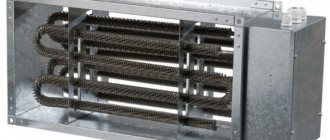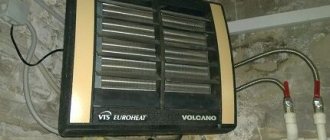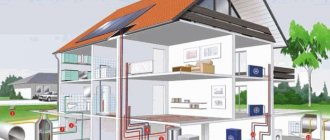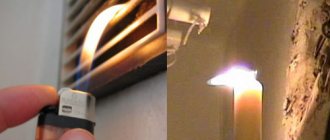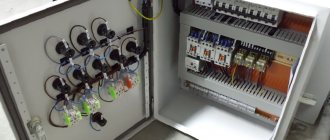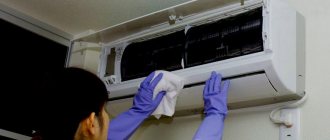21-30 m2
Air conditioner with forced ventilation Roda RS-A09F/RU-A09F
72 reviews
Briefly about the product:
- heating and cooling of rooms up to 25m²
- ventilation, temperature maintenance, night, dehumidification mode
- cooling power 2650 W / heating 2750 W
- remote control
- energy efficiency class A
- noise level of the indoor unit 26 dB
Where can I buy:
Air conditioner with forced ventilation Electrolux EACS/I-09HM/N3_15Y
28 reviews
Briefly about the product:
- line: Monaco Super DC Inverter
- heating and cooling of rooms up to 25m²
- ventilation, temperature maintenance, night, dehumidification mode
- deodorizing filter, fine filter
- cooling power 2490 W / heating 2800 W
- remote control
- energy efficiency class A
- noise level of the indoor unit 23 dB
- display type: normal
Where can I buy:
Air conditioner with forced ventilation Electrolux EACS/I-09HVI/N3
28 reviews
Briefly about the product:
- line: Viking
- heating and cooling of rooms up to 25m²
- ventilation, temperature maintenance, night, dehumidification mode
- ventilation, temperature maintenance, night, dehumidification mode
- cooling power 2640 W / heating 3000 W
- remote control
- energy efficiency class A
- noise level of the indoor unit 21 dB
- display type: hidden
Where can I buy:
Air conditioner with forced ventilation Ballu BSD-09HN1
26 reviews
Briefly about the product:
- line: Lagoon
- heating and cooling of rooms up to 26m²
- ventilation, temperature maintenance, night, dehumidification mode
- deodorizing filter
- cooling power 2640 W / heating 2780 W
- remote control
- energy efficiency class A
- noise level of the indoor unit 26 dB
- display type: hidden
Where can I buy:
Air conditioner with forced ventilation Ballu BSUI-09HN8
19 reviews
Briefly about the product:
- line: Platinum Evolution DC inverter
- heating and cooling of rooms up to 26m²
- ventilation, temperature maintenance, night, dehumidification mode
- anion generator
- cooling power 2600 W / heating 2900 W
- remote control
- energy efficiency class A++
- noise level of the indoor unit 19 dB
- display type: hidden
Where can I buy:
up to 20 m2
Air conditioner with forced ventilation Aeronik ASI/ASO-07HS4
46 reviews
Briefly about the product:
- heating and cooling of rooms up to 20m²
- ventilation, temperature maintenance, night, dehumidification mode
- cooling power 2250 W / heating 2350 W
- remote control
- energy efficiency class A
- noise level of the indoor unit 26 dB - 40 dB
Where can I buy:
Air conditioner with forced ventilation Electrolux EACS/I-07HM/N3_15Y
27 reviews
Briefly about the product:
- line: Monaco Super DC Inverter
- heating and cooling of rooms up to 20m²
- ventilation, temperature maintenance, night, dehumidification mode
- deodorizing filter, fine filter
- cooling power 2200 W / heating 2300 W
- remote control
- energy efficiency class A
- noise level of the indoor unit 23 dB
- display type: hidden
Where can I buy:
Air conditioner with forced ventilation Mitsubishi Electric MSZ-LN25VG / MUZ-LN25VG
21 reviews
Briefly about the product:
- heating and cooling of rooms up to 20m²
- ventilation, temperature maintenance, night, dehumidification mode
- deodorizing filter, plasma filter, fine filter
- cooling power 2500 W / heating 3200 W
- control from remote control and smartphone (wi-fi)
- energy efficiency class A
- noise level of the indoor unit 19 dB - 45 dB
Where can I buy:
Air conditioner with forced ventilation Electrolux EACS-07HAT/N3_19Y
17 reviews
Briefly about the product:
- heating and cooling of rooms up to 20m²
- ventilation, temperature maintenance, night, dehumidification mode
- deodorizing filter
- cooling power 2200 W / heating 2340 W
- remote control
- energy efficiency class A
- noise level of the indoor unit 27 dB
- display type: hidden
Where can I buy:
Air conditioner with forced ventilation Mitsubishi Heavy Industries SRK20ZS-S / SRC20ZS-S
6 reviews
Briefly about the product:
- heating and cooling of rooms up to 20m²
- ventilation, temperature maintenance, night, dehumidification mode
- deodorizing filter, fine filter
- cooling power 2000 W / heating 2700 W
- control from remote control and smartphone (wi-fi)
- energy efficiency class A
- noise level of the indoor unit 19 dB - 36 dB
- display type: normal
Where can I buy:
Air conditioners with forced ventilation work like conventional split systems. In addition, they can include fresh air from the street in the air exchange. It undergoes multi-stage cleaning that traps dust, aerosols, insects and other contaminants. This scheme allows you to maintain high quality indoor air, saturating it with oxygen.
What is a forced air conditioner?
Many apartment buildings in our country were built quite a long time ago. Their ventilation systems had become dirty and unusable. In addition, today in most rooms plastic windows are installed, which also impair natural ventilation.
A regular air conditioner cannot fix this because it is designed to cool the air in a confined space. And the amount of carbon dioxide continues to increase, which can harm human health. To improve the health of the internal environment, a new type of device was developed - an air conditioner with forced ventilation for an apartment. Let's see what the difference between the devices is.
Standard models include two main elements:
- evaporation unit – located within the room;
- external unit - a compressor-condensing device mounted on the facade.
The first block takes air from the room, after which the cooling process occurs by transferring thermal energy. The carrier in this case is freon, which initially has a gaseous form. After passing through the second block, it turns into a liquid. To return to its original form, freon must take away some of the heat from the air from the evaporator unit. And the cooled air returns back to the room.
In short, the operation of the air conditioner is recirculation, that is, no replacement of air occurs. According to GOST standards, at least 30 cubic meters per person per hour must enter the room. Conventional air conditioners cannot provide this, and this is their main drawback. To allow air to enter, you have to open the windows, which in hot weather partially neutralizes the effect of cooling equipment.
Supply air conditioners work completely differently.
Article: “Air conditioners with fresh air from the street”Introduction.
For many thousands of years, humanity has been dreaming of getting rid of the heat with the help of some kind of magical device, and finally, in 1902, the first air conditioning refrigeration machine, the first air conditioner, appeared. Subsequently, air conditioners were constantly improved (1929 - the first room air conditioner, 1931 - the creation of safe freon, 1961 - the first split system (2 units), 1968 - the first multi-system, 1981 - the first inverter air conditioner), then the air conditioners changed only small parts , for example, freon to a safer one, or added filters, or reduced the volume of its operation. Actually, all this will help us when discussing the actual main topic of the article.
Installing an air conditioner with air supply from the street is a rather complicated procedure, which, in addition to installation skills, also requires special expensive tools. Includes: installation of an outdoor unit (usually outside on the wall of a house), an indoor unit (indoors to fulfill its main purpose - to cool the room in the summer) and tubes and wires connecting them (actually for work). Why is everything usually divided into 2 blocks? Why can't we do everything in 1 block? Of course you can, and it’s called a “window” air conditioner, which makes a lot of noise (it really puts pressure on your ears) and has virtually no benefit. Why is this happening? The noise comes from a special engine (after all, who else will cool it all if not the engine?) and the low efficiency because the tubes inside the window air conditioner are not enough for normal circulation of coolant (in particular gas) - hence all the problems and no one among the engineers can yet solve them. That’s why they came up with split systems, a state of 2 blocks and tubes connecting them with a length of at least 2.5 meters (this is the minimum amount required for freon to go from a liquid to a gaseous state and back with maximum efficiency. That’s it. A good analogy is a refrigerator, which hums a lot, but at the same time cools the volume of its chamber which is 100 times smaller than the room. Our consultants will be happy to select an air conditioner with a forced ventilation mode for your apartment.
Now actually to the essence of the question.
Doesn't the air conditioner bring air from the street? Of course not. Supply air conditioners take air from the room itself through an opening at the top of the air conditioner and send it through the radiator when cooled back into the room. The only channel connecting the indoor air conditioner unit with the street (copper pipes) carries only freon gas (refrigerant), but not air. This is a very common misconception.
But most often, an influx of “fresh” air from the street is not required. After all, the air outside is not always cleaner than at home, only if you have a park or forest outside your window. Otherwise, what is the point of letting air from the street polluted by car exhaust fumes into our apartment? In addition, this still will not solve the problem of full ventilation.
But if we nevertheless decide to find and buy an air conditioner with an influx of fresh air in Moscow and the Moscow region, then let's understand the essence of this issue and find the “right” solution!
So, there are currently 3 companies on the climate market that offer air conditioners with air supply from the street: Daikin (FTXR / FTXZ series - Ururu Sarara), Haier (Lightera series) and Hitachi (JH series - Air Exchanger), which belong to 2 types of such “inflow”. The general principle of “inflow” is implemented by extending a second hose to the street (the first is water drainage) through which air already passes into the indoor unit, from where it mixes with the air that the air conditioner takes from the room (that is, the air conditioner does not output pure air from the street , but still interferes with it in some proportions with what is present in the room). Such air conditioners are called air-mixed air conditioners. And here is the key nuance: what proportions of the “mixture” will it be? There are 2 options for the relationship: 1) the actual thickness of this second hose (mixture), the larger the better, and also 2) the air flows simply “by gravity”, that is, without pump pressure from the street or not, if there is a pump that drives air under pressure - But, of course, the effect of such an influx will be noticeably greater if, according to our estimates, the mixture by gravity is 10% from the street and 90% from the room (that is, it takes at least an hour or two for the air in the room to become noticeably fresher), and if under pressure pump, then we estimate the effect to be 50% / 50%, that is, within an hour the air will be noticeably “fresh”. Our website offers a wide selection of air conditioners with forced ventilation at affordable prices.
Daikin ( FTXR / FTXZ series - Ururu Sarara) - inlet pump: yes (built into the external unit), hose diameter: 80-100 mm, cost from 150,000 rubles.
Haier (Lightera series) - pump for air supply: yes (purchased separately, installed separately), hose diameter: 20-25 mm, cost: from 30,000 rubles + 15,000 for air supply unit.
Hitachi ( JH series - Air Exchanger) - pump for inflow: not provided - just “throw out” the hose, hose diameter: 20-25 mm, cost: from 45,000 rubles.
Additionally:
Why is air flow necessary?
A person is unable to breathe air with high concentrations of carbon dioxide for a long time. The problem is solved by an influx of fresh air, even if it comes from a polluted street, but we still need it. True, most often the natural flow of air through an open window or full ventilation is much more effective (but this will be a rather expensive option and will not be suitable for every apartment (due to large air ducts)).
Useful links from our website:
— Prices for installation
work
— Main types of installations
(diagrams with clear comments)
— You can see what kinds of installations there are on the page with photographs of our installations
— History of the development of our company
— Author's articles about air conditioners written in clear language
— Section "Promotions"
which will help you save!
The main thing to remember:
The main guarantee to the buyer is given not by the manufacturer, but by the company (necessarily authorized) that installed the air conditioner.
_________________________________________________
Sincerely,
Online store of climate control equipment KONDILAK
www.kondilak.ru
email for requests: This e-mail address is being protected from spambots. You need JavaScript enabled to view it
Author of the article: Mikhail Pankratov (commissioned by the store kondilak.ru)
All rights to materials and news published on the website www.kondilak.ru are protected in accordance with the legislation of the Russian Federation, are the exclusive property of the copyright holder and are protected, inter alia, by the “anti-piracy” law 364-FZ of November 24, 2014. Quoting is allowed without the consent of the Administration site no more than 50% of the volume of the original text with a mandatory direct hyperlink to the page from which the material was borrowed. The hyperlink should be placed directly in the text that reproduces the original material (from the site www.kondilak.ru) before and after the quoted block. Otherwise, the Site Administration has the right to apply to the court with a demand for the “eternal” blocking of the website domain that violates its rights in accordance with Federal Law 364-FZ of November 24, 2014.
The principle of operation of an air conditioner with forced ventilation
The supply units also include two blocks. The main elements of the first of them are:
- cooler;
- filter;
- fan;
- control Panel.
Elements of the second – remote module:
- Heat pump;
- compressor-condensing unit;
- microprocessor control.
The connector of the considered blocks is the freon pipeline. A heater with electronic control is also connected to the indoor module.
Air is simultaneously taken from both the room and the street. They enter the mixing chamber, where, accordingly, mixing occurs. The resulting air passes through filters and is processed according to a given mode, that is, cooled, heated or dried. And finally he goes back into the room. Thus, the air inside is not only cooled, but also refreshed.
Many of the modern models are additionally equipped with a microprocessor control system. Thanks to it, the device automatically maintains the specified conditions in the room. For example, if in the summer it cools the air, then in the fall and winter the air conditioner will heat it. Using the control module, you can adjust the specified parameters. The variety of functions and settings depends on the air conditioner model.
Supply duct models
The function of replacing exhaust air masses with air from the street is fully implemented only in ducted air conditioners, so we will analyze their features and performance characteristics in more detail.
A properly designed and installed ducted split system copes with the tasks of ventilation and control of the indoor microclimate.
Distinctive features of an air conditioner with inflow
Recirculation models of duct air conditioners (CC) are similar in operating principle to conventional split systems, but they differ in design and installation location. Internal modules are built into suspended ceiling structures, and air circulates through the channels connecting them to the outdoor unit.
Image gallery
Photo from
Design features of the channel system
Design of the indoor unit QC
Air circulation within the system
Duct fan for forced circulation
This is what a simple recirculation model looks like, unable to supply fresh air. In order for the system to perform the supply function, a built-in heater is required. This is regulated by SNiP rules, according to which the lower temperature threshold of air masses coming from the street must be +14 °C.
If the outside temperature is above -15 °C, the heat pump handles the heating function. However, at lower temperatures, air conditioner models with water or electric heaters are used. Heating equipment can be either additionally installed or built-in.
The heating system is equipped with an automation unit, thanks to which the fresh air supply is adjusted in different modes, depending on the season. The automatic unit is controlled using a remote control
Programmable air supply systems are more expensive than conventional room modifications with wall installation, but they are much more efficient and functional precisely due to the combination of ventilation and air conditioning. The amount of oxygen in the air meets sanitary requirements, the temperature is easily regulated, and the appearance does not create discomfort, since all the working parts of the system are located in an invisible area, above the ceiling.
Operating principle of the supply system
To transport air from the street to the premises, air ducts are provided, which conventional split systems do not have. First, air from the street moves through the outdoor unit into an insulated channel, then into the mixing chamber. There, the incoming air combines with the exhaust air, refreshing it.
Then the air mixture passes through the filters and, according to the selected mode, is processed. Air masses are dehumidified, heated or cooled. After this, purified, filtered, partially refreshed air at a given temperature enters the premises.
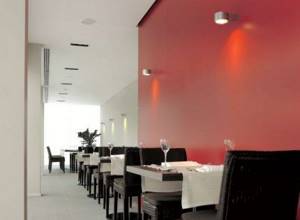
Channel modifications with admixture are used in large rooms that are separated from each other by non-permanent partitions. These are apartments with ceilings of 3 m, clinics, food establishments, sports and educational institutions, offices, etc.
Typically, the temperature maintained depends entirely on the season. In summer, supply duct air conditioners work for cooling, in winter - for heating. In the cool season, the operation of the heat pump is sufficient; the heater does not need to be used during this period.
Advantages of an air conditioner with forced ventilation
Split systems with forced ventilation from the street have undoubted advantages that make their use more effective, useful and convenient than the use of standard air conditioners:
- Influx of fresh outdoor air throughout the year.
In winter, cold air from the street, passing through the system, warms up to a set temperature. Semi-industrial split systems provide a higher percentage of air supplied from the street to the room than wall-mounted household air conditioners with the option of adding fresh air. - Possibility of simultaneous work in several rooms.
Modern split systems provide the ability to operate efficiently both in large areas and in several rooms at once. - Quiet operation.
Such split systems operate quite quietly. This is ensured by special materials used in the manufacture of devices, as well as design solutions. - Economic benefit.
For spacious rooms with a large number of rooms, it is more profitable to purchase a semi-industrial or industrial split system with forced ventilation, since in this case it will be more expedient than purchasing several household systems with air admixture separately for each room.
Types of supply air conditioners
All air conditioners with air intake from outside operate according to the following principle:
- When the user switches the split system to cooling mode, the supply ventilation function is activated.
- The damper for supplying outside air opens through an air duct laid from the street into the room through the external wall.
- The fan picks up outside air and forces it through the filter. After cleaning, it is mixed with the main air flow from the room, cooled and further processed - humidification, dehumidification, ionization (if the specified functions are available).
Important clarification. In air conditioners from different manufacturers, the inclusion of external air flow is implemented in different ways. We will examine this issue below in a review of each type of home cooler.
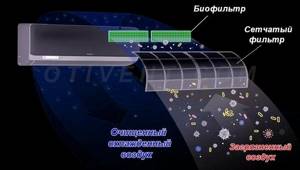
In online stores of climate control household appliances you can find the following types of supply air conditioners:
- classic split systems with internal units of wall, floor (column) and ceiling installation;
- window, mobile and floor-wall coolers without an external unit;
- ducted air conditioning systems.
Let's briefly look at the design and operating principle of each of the listed units.
Split systems with fresh air supply
We propose to study the supply of inflow in “splits” using the example of the Japanese climate control unit Hitachi RAS-10JH4/RAC-10JH4. The price of the unit is from 43,500 rubles. (675 cu), technical characteristics look like this:
- heating power – 3.4, cooling – 2.6 kW, service area – 25 m²;
- compressor type – inverter;
- total amount of processed air – 510 m³/h, supply air – maximum 25 m³/h;
- additional functions - humidifier, ionizer, ultraviolet and regular filter-cleaner.
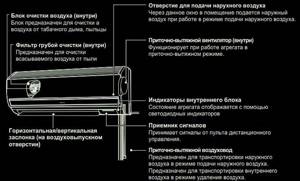
A special feature of the air conditioner is the presence of an independent supply and exhaust fan, which can be turned on automatically or manually. Accordingly, an air pipe with a diameter of about 40 mm goes out from the indoor module to the street.
How a split system works in automatic mode:
- A special sensor measures the degree of air pollution in the room. Reacts to lack of oxygen, various suspended particles, cigarette smoke. When the concentration of harmful substances reaches a set threshold (can be configured), the sensor starts the fan.
- The removal of polluted air masses to the street begins and lasts 20 minutes. Then the pumping mode is turned on, the fan takes air from the outside and supplies it to the room through a special hole or together with the main flow, as shown in the diagram.
- Air intake/exhaust operates regardless of the air conditioning mode.

Scheme of supply air mixing in the split indoor unit
Clarification. When cooling/heating is turned on, the inflow is mixed into the general flow. If the air conditioning is turned off, the fan impeller drives supply air through a special opening in the indoor unit.
The user can activate the ventilation manually by pressing the corresponding button on the remote control. One condition: the ambient temperature must be within 3...30 °C, otherwise the damper will not open and the fan will not start. In this way, the split system provides protection against condensation and excessive energy consumption for heating or cooling the supply air. For a brief overview of the device from another well-known brand Daikin, watch the video:
The operation of the remaining two-block air conditioners with ventilation is organized in a similar way. Most models only provide air supply, which turns on automatically along with cooling (not when heating). In cassette modules mounted in the center of rooms, ventilation mode is not provided.
Monoblock units
Here we will again look at an example - a wall-floor air conditioner with a supply of air Climer SX-25. In fact, this is an entire climate station equipped with the following elements:
- evaporator, condenser and compressor of a refrigeration unit;
- recuperator for transferring heat from exhaust air to influent air;
- fan coil unit connected to the water heating system of a private house or apartment.
Reference. Such climate control units are called central air conditioners. The cost of monoblocks of the Climer SX series starts from 68,200 rubles. (1050 USD).
The listed equipment plus a filter system and fans are built into a single housing, suspended from the wall above the floor, as shown in the photo. From the rear panel there are 2 pipes leading out onto the street - supply and exhaust.
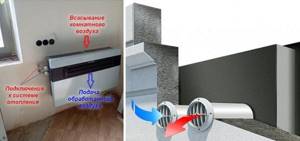
What this air conditioner can do:
- Clean and humidify air streams before entering the room.
- Remove polluted air from the room and at the same time introduce fresh air.
- Save electricity. The flows exchange thermal energy in the recuperator (heat in winter, cold in summer).
- Operate in air heat pump mode as long as the outside temperature allows (up to +5 degrees).
- Heat the room using the built-in fan coil connection to the home heating system.
As you can see, supply ventilation is one of the many functions of the Climer stationary monoblock. The air conditioner model SX-25 supplies a room of up to 25 m² and has a capacity of 400 m³/h, with an inflow volume of 30 m³/h. The power corresponds to a “split-nine” - 2.64 kW for cold, 2.78 kW for heat.
The supply and exhaust mode operates in the air conditioner constantly (turns on automatically) or at the user’s request. Air is sucked in by a fan through one pipe with a diameter of 160 mm and expelled from the second (Ø150 mm).
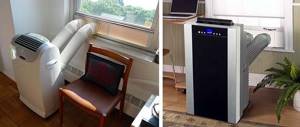
Of course, there are other, simpler and cheaper mobile air conditioners with outdoor air intake. These are models with two air ducts that need to be ducted outside (above in the photo). The second pipe is just for inflow. What is interesting: the volume of supplied air in any similar installations does not exceed 30 m³/h.
Ducted air conditioning systems
Any duct air conditioner can be called a supply air conditioner. Coolers of this type are also called open-frame coolers, since they do not have facing panels and are built inside rectangular air ducts. Such an air conditioner will process any air that comes to it through the ventilation duct, including supply air.
How it works in an apartment or country house:
- A forced ventilation system with channels hidden under the ceiling is installed in the home.
- The indoor air conditioning unit is mounted on the air duct after the filter element and fan. The external module is placed on the facade of the building and connected to the ducted freon lines.
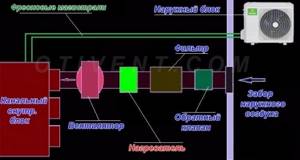
- Next, the main thing: partial recycling is organized. This means that fresh and internal polluted air is supplied to the air conditioner input in the same or different proportions - 50/50, 70/30 and so on (determined by calculation).
- After cleaning and cooling, the air masses are directed into the premises through the supply grilles.
Note. We are talking about devices designed specifically for cooling air flows. In addition to them, there are many other duct-type ventilation units - recuperators, heaters, purifiers and entire air treatment complexes.
Disadvantages of forced air conditioner
It should also be noted here that cooling/heating systems with fresh air supply are much more economical than a separate installation of a ventilation system with air supply from the street and an air conditioning system.
- many models make too much noise due to the presence of an additional fan, so the indicators are on the verge of 30 dB, which, according to the law, cannot be exceeded at night;
- supply air conditioners are not capable of completely replacing a full-fledged ventilation system;
- higher cost when compared with conventional air conditioners.
It cannot be said that the listed disadvantages can be called significant. And yet, they scared away many potential buyers - this type of air conditioner is not particularly popular in our country.
Pros and cons of ventilated air conditioners
Let's start with the positive aspects, of which there are few. The use of a split system or a monoblock with an inflow allows you to refresh the air in the room, and in some cases remove some of the polluted air. The most successful solution in this regard is a duct unit + fan + air duct network. The implementation method in the apartment is shown in the video below.
An air conditioner with a forced ventilation function is good for children's rooms and bedrooms, as well as rooms where it was not possible to ensure adequate air exchange. By buying a two-in-one cooler, you kill 2 birds with one stone - you organize air conditioning and renewal of the air environment (within certain limits).
The main disadvantage of such equipment is not even the high price, but low performance. If you study our guide to calculating ventilation in an apartment, you will quickly understand that 25-30 cubic meters of fresh air per hour per living space is not enough. For a room of 25 square meters you need a minimum of 67 m³/h.
Important point. Only ducted systems with built-in air conditioning units can provide high inflow performance. This is the best option for forced mechanical ventilation, but it is also the most expensive.
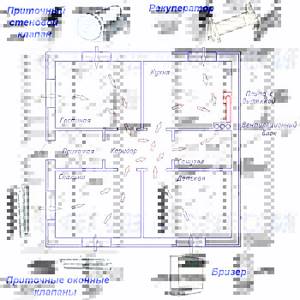
Let's list the other disadvantages:
- In second place is the price of equipment. Comparative calculation: a regular “split” Haier HSU-09HTL103/R2 costs 285 USD. e. plus a wall inlet valve 25 cu. e., total – 310 USD. e. The air supply unit of the same brand Haier HSU-09HNF03 will cost 550 USD. e. You will have to drill the wall in any case.
- It is necessary to update the air environment in all residential premises. Buying and installing an air conditioner with ventilation in each room is not an option; a multi-split system will cost even more.
- The cooler provides fresh air while the fan is running. If the lights are turned off or the unit’s automation is triggered, the environment update will stop.
- A constantly running fan produces continuous noise.
Reviews from forum participants about monoblock complexes and mobile supply air conditioners are not very flattering. The former have problems with electronics, the latter make a lot of noise and take up space.
Types of air conditioners with forced ventilation
There are several types of air conditioners with forced ventilation. Depending on the specifics of the premises, one or another of them can be used.
Wall-mounted models with forced ventilation
Models whose internal unit is mounted on a wall are the most popular for the improvement of residential premises.
There are models that provide a comfortable microclimate on an area of 10 m², but there is also more powerful equipment designed for rooms up to 100 m². Not long ago, inverter models equipped with a supply and exhaust fan appeared.
Regardless of whether the air conditioner is operating in heating or cooling mode, the supply and exhaust system can operate in parallel. An example of a wall-mounted device with the function of supplying air from the street is the Air Exchanger series of the famous HITACHI brand.
What is special about multi-split systems?
Speaking about air conditioners in a general sense, it is necessary to mention multi-split systems, which are also used to equip multi-room apartments, private houses, office and industrial buildings.
They differ from ordinary ones in that they have only one remote block, while there can be several internal ones. The minimum quantity is two modules, the maximum is limited to four. If you use more indoor units, the system will lose its performance and will not operate at full capacity.
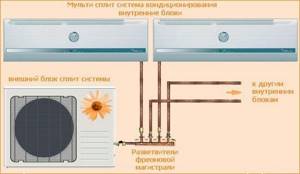
The number of pipelines increases, accordingly, the cost of equipment increases and the installation of some parts of the structure becomes more complicated. It is important to create conditions for laying all connecting elements (+)
The multi-split system is not always used, but only in certain cases when the installation of a large number of outdoor units is impossible for a number of reasons:
- the building is a historical or architectural monument;
- there is a ban on installing remote blocks on the facade;
- For hanging equipment, the architecture of the building provides certain places limited in area.
Sometimes the installation of a large number of remote modules is refused for aesthetic reasons: the beautiful facade of the building, hung with oversized buildings, looks unpresentable.

The rules for the improvement of large cities are periodically amended to prohibit the placement of air conditioners on facades facing central streets. The solution is to install the block on the courtyard wall of the building
The advantage of a multi-system is the installation of one remote module, the disadvantages are complex work on installing pipelines, reduced productivity and reliability. In addition, all internal modules must operate in identical modes: either heating or cooling.
Manufacturers of air conditioners with forced ventilation
If you are thinking about which manufacturer is better to choose an air conditioner with forced ventilation, pay attention to the most well-known brands. Perhaps the cost of such devices will be slightly higher than what is installed by not very popular companies. But you can be confident in the quality and reliability of these air conditioners. The most famous manufacturers today are:
- Hitachi is a huge conglomerate from Japan, known throughout the world for its various equipment, including air conditioners;
- Daikin is another Japanese company that is a leader in the production of air conditioners;
- Mitsubishi is an air conditioner manufacturer almost as good as the previous company, producing some of the most modern and advanced devices;
- Haier is a Chinese company that has managed to gain a foothold in the global (and in particular Russian) market thanks to its mid-range price category;
- Toshiba is again a manufacturer from Japan, known to everyone for its high-quality household appliances, including air conditioners at competitive prices.
Tips for choosing a forced air conditioner
First of all, when choosing an air conditioning system with forced ventilation, it is worth assessing the conditions in the room where you are going to install the air conditioner. If the building is equipped with good ventilation, which effectively ensures air exchange, then it is not necessary to spend additional money on an air supply device.
Also evaluate the size of the room. On high ceilings, you can place cassette air conditioners that will not take up free space. And with the help of a suspended structure you can disguise the internal blocks. For low ceilings, it is better to choose models with wall or floor units. If the room has a large area, you should choose a powerful air conditioner, for example a column type.
Always carefully read the technical characteristics of air conditioners. Among them, not only the power is indicated, but also the area for which it is designed.
The financial issue, of course, always remains one of the most important for our compatriots. The cost of models is affected not only by their power, but also by the presence of additional functions. Therefore, in order not to overpay, decide in advance what exactly you need and what features you can do without.
Today, air conditioners are already available in almost all offices and many apartments. A variety of models allows you to choose a device that suits both operating conditions and cost.
Benefits of multi-zone air conditioning
Multi-zone maintenance of premises is a more advanced version of multi-split systems, which creates a certain microclimate over a large area. The fundamental difference from standard split systems is the increased length of highways connecting modules located in different places.
Advantages of a multi-zone system:
- up to 20 internal units can be connected to 1 remote unit;
- the distance from the internal module to the external one is up to 150 m (in some cases more);
- height difference between modules is 50 m.
Thanks to the listed parameters, the remote outdoor module is installed in the most convenient remote locations - in the attic, roof, in the yard behind a fence, etc.
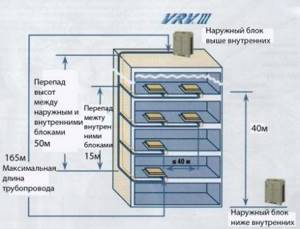
Scheme of possible installation of the outdoor unit. If for some reason installation on the roof cannot be carried out, the module is installed directly in the courtyard of the house, ensuring safety
A multi-zone system is more economical, since the control of inverter climate control equipment allows you to change the system power depending on the number of functioning indoor units.
In this case, you can use modules that are completely different in type and performance. Adjustment and control over the operation of all equipment can be done in system mode, from one remote control.
You can compare conventional and inverted climate control systems and get an idea of their pros and cons by reading our article. Before making a decisive choice, it is worth familiarizing yourself with useful information.
Supply ventilation as an alternative to forced air conditioning
An alternative option for installing an air conditioner with fresh air is to install fresh air ventilation.
Ventilation itself comes in different types:
- Supply air (supplies fresh air from the street into the house, exhaust air is not removed)
- Exhaust (only air is removed from the room)
- Mixed or supply and exhaust (works due to the formation of counter flows through which fresh air enters and old air is removed)
The first type can be used if you already have your own exhaust ventilation (forced or natural).
The second type is not used in rooms where constant air renewal is necessary. Supply and exhaust ventilation is the most effective and preferable for apartments and houses.
They can also be local (for a specific room) or central (for several rooms).
Sources:
- https://zen.yandex.ru/media/id/5e4e83a0b38ee002b5fc11f6/splitsistemy-s-rejimom-pritochnoi-ventiliacii-5ebc0d356f769b4f23218d3f
- https://stroy-podskazka.ru/kondicionery/s-pritochnoj-ventilyaciej/
- https://sovet-ingenera.com/vent/cond/kondicioner-s-pritokom-svezhego-vozduxa.html
- https://dantex.ru/articles/konditsioner-s-pritokom-svezhego-vozdukha/
The main advantages of supply air conditioning
Among the main advantages of an air conditioning system with air supply are the following:
- Year-round refreshment of the atmosphere at home. The air taken from outside is automatically heated or, on the contrary, cooled, depending on the equipment settings and internal microclimatic conditions. Thanks to this, the atmosphere in the house will always be fresh and at the right temperature - as opposed to natural ventilation, when when you open the vents or windows, the air in the house either immediately cools or heats up, which makes this method very limited and dependent on weather conditions.
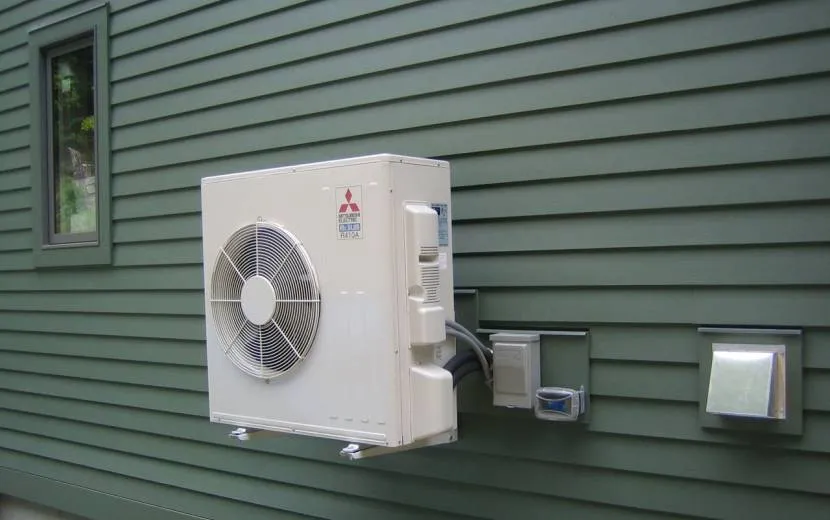
The external module of the system provides the intake of street air to enter the enclosed space. Source stroy-podskazka.ru
- Deep cleaning of air supplied from the street. A modern split system with a supply ventilation function is equipped with a special multi-level filtration system. This allows you to maintain a fresh home atmosphere around the clock, regardless of external conditions - smoke, smog, exhaust gases, dust and other factors that pollute the environment.
- Coverage of different areas and premises. New models of climate control equipment of this type provide ventilation simultaneously in several areas of the living space - depending on local microclimatic conditions. For example, the kitchen requires certain values of ventilation intensity and temperature, while the bedroom requires completely different values.
- Automatic operation control. Heating elements, outdoor and indoor unit components are controlled by a high-speed processor based on user-specified settings and sensors. For this purpose, the ventilation rate and the desired heating level in the room are set through the control panel.
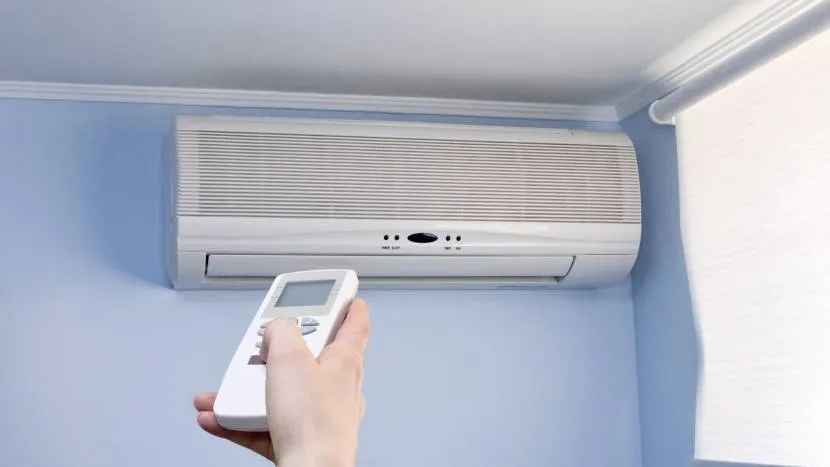
The split system works automatically - the user only needs to turn it on and set the settings Source stroy-podskazka.ru
- Minimal technogenic impact on others. The newest pieces of equipment are small in size and weight, making them convenient to install on a wall or ceiling (depending on the version). Thanks to the special materials they contain, the equipment produces virtually no noise or vibration.
Note! The ventilated air conditioner is equipped with microprocessor high-speed control. Air conditioning and ventilation parameters are maintained automatically all year round, quite accurately according to weather conditions. Therefore, the device consumes only as much energy as required to operate within the specified settings.
See also: Catalog of companies that specialize in complex installation of internal engineering systems
Read also:
Stages of ventilation design Calculation of the ventilation cross-section Advantages and disadvantages of the dehumidification mode Duct ventilation design Pros and cons of inverter air conditioners
See also:
- Ventilation design
- Which split system is better: inverter or conventional?
- How does a ducted air conditioner work?
- How to clean your home air conditioner
- Which is better: climate control or air conditioning?
- How to clean your air conditioner yourself
- Ventilation repair
- How to remove an air conditioner with your own hands
- Ventilation calculation
- How to calculate the power of an air conditioner
- How to connect the hood?
- How to hide an air conditioner on the facade
- How to install air conditioning on the balcony
- Types of ventilation
- Drying mode in an air conditioner - what is it?
Microprocessor control system
The electronic control system automatically maintains the required parameters of the air conditioning and ventilation system at any time of the year. In summer, the air is cooled and the room is maintained at the set temperature. In autumn and spring, the air conditioner switches to “heat pump” mode and effectively heats the air without turning on air heaters (electric or water). If the outside temperature drops below 0C, an additional heater (duct-type air conditioner) is turned on. The electronic heater control module allows you to smoothly regulate its power depending on the outside air temperature, which ensures minimal power consumption.
